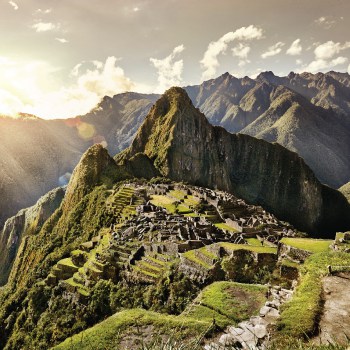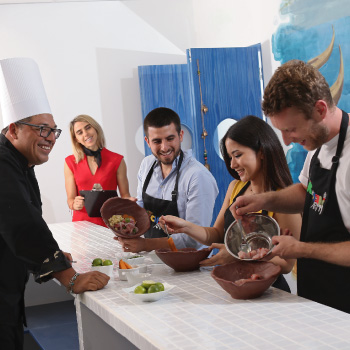Ayacucho Ultimate Travel Guide
Located in Southern Peru, Ayacucho is often hailed as a one of a kind destination, effortlessly combining the colors, the history and the adventure that so many travelers revel in on their journey through Peru. Whether you choose to travel with your friends, your family or spend a little me-time getting to know these streets, you will fall in love with the city that locals know as Huamanga.
About Ayacucho
Originally founded as San Juan de la Frontera de Huamanga (hence the name from the locals), Ayacucho is the capital of the province Huamanga. It is located along the eastern slope of the Andes mountain range at an altitude of 2761 meters. The city has a dry climate, even when you consider the rainy season (from December to March) the sun remains shining all year round.
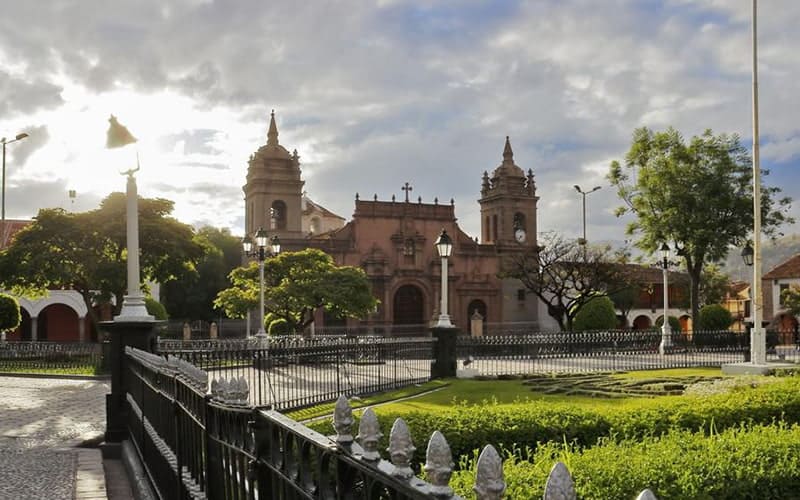
One of the most important artistic and architectural complexes in Southern Peru, Ayacucho can also be known as the City of Churches (Ciudad de las Iglesias), thanks to its number of churches: it has more than 30 Renaissance and Baroque style churches, each adorned with beautiful paintings and intricate wood carvings. If architecture is your thing, you can also check out the many colonial-style mansions and Inca remains that are dotted around the city.
It’s not just the churches that are attracting more and more visitors each year, Ayacucho is home to some truly beautiful and unique traditional handicrafts, even being recognized as the “Capital of Popular Art and Peruvian Handicraft” in 2017. The most famous of these crafts are the alabaster carvings. (Alabaster is known as the stone of the region.) There is also pottery and fine wire jewelry called filigree, which is made in the Santa Ana neighborhood. The most sort after trinket from Ayacucho however, is the retablos, which is a painting devoted to a folk-law, traditionally in a Roman-Catholic style of art, and presented in small portable boxes.
A huge part of Ayacucho’s culture is based in its traditional activities, previously the Carnivals and the Holy Week have been declared as “National Cultural Heritage in Perú” in 2003 and 2018 respectively. This sanctuary deserves to be explored with enthusiasm and a willingness to discover the pleasure of Ayacuchan music and culture.
Why is it Called Huamanga?
Guaman qaqa is a Quechua word that refers to the place where the Spanish arrived. According to local people, during one of his trips through the zone, Viracocha Inca (one of the leaders of the Inca Empire) decided to have a break from traveling when a falcon rested on his shoulder. Legend says he told the animal: “Guaman Ka” meaning “eat, falcon”.
Why Visit Ayacucho?
The name Huamanga was changed to Ayacucho by decree of the liberator, Simón Bolívar, on the 15th of February 1825. This was done as a homage to the victory of the army in the Ayacucho Battle.
Ayacucho is a combination of two Quechua words: “aya” meaning soul and “k’uchu” meaning dwelling. In this sense, Ayacucho means “souls’ dwelling”. This is referring to a place where many human bones were found from the different battles that took place in the area.
Food in Ayacucho
- Cuy Chactado (flattened guinea pig): Fried guinea pig with ground corn, served with golden potatoes and salad. A must try for every traveler!
- Pachamanca: A variety of meats, potatoes, corn, sweetcorn, and broad beans, cooked in a hole in the gound, covered with earth and hot rocks. This is similar to the pre-Hispanic style of cooking.
- Ayacucho marinade: Stew made from pork, onions and potatoes, dressed with red chillies and spices.
- Qapchi: A starter, made with “cachipa”- crumbled fresh cheese mixed with chillies, “rocoto” (hot chili), milk, oil and chopped onions, served over floury potatoes.
- Teqtes: Stew made from peas, squash, quinoa, broad beans and chuño, dressed with chillies, garlic, fresh cheese, milk and eggs.
- Puchero: A dish made from cabbage, fruits, chickpeas, sweet potatoes and yucca, usually prepared during carnivals.
- Puca Picante: A main dish with potatoes, peanuts and red chilli peppers, served with fried pork and white rice.
- Ponche: A drink made of peanuts, sesame seeds and various spices.
- Traditional desserts: Ayacucho is known for its wide variety of breads, including the “wawas”, the “balay sweet bread” (maicillos, suspiros or meringues, oquendos).
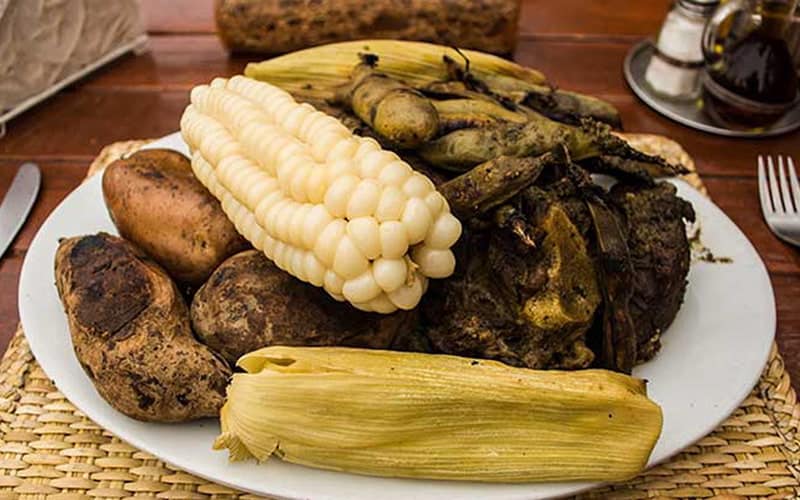
Things to See in Ayacucho
- Basilica Cathedral: Located in the Plaza Mayor of Ayacucho, and built in the 17th century by King Philip III of Spain, it was dedicated to the Virgen de las Nieves (Virgin of the Snow). The construction combines Renaissance and Baroque style of architecture. Its facade complements the wealth within, where ten altarpieces, all covered in gold-leaf surround the hall. Some of these are dedicated to Nuestra Señora de Socos (Our Lady of Socos), Señor de Burgos (Lord of Burgos) and Niño Llorón (Crying Child).
- Plaza Mayor: Characterized by stones archways on the first level, pillars with balustrades on the second level and roofs of red clay in the third level, the surrounding buildings of the plaza date back to the 16th and 17th century. It’s the perfect place to go if you’re looking for a relaxing walk.
- Temple and Convent of Saint Francis of Assisi: The public opening hours of this historic place are from Monday to Saturday in two-time slots: 7:00 am – 8:00 am and 6:00 pm – 6:30 pm. Sunday opening times of the convent are 9:00 am – 10:00 am. The building was an attempt to recreate the Greco-Roman Peninsular style, which is typical of the Andes. The most important structure inside the church is the high altar, which is formed of four carved and gilded wooden figures. If you’re on the hunt for culture and history, this is the perfect place for you. It has the largest bell in the city, and houses a beautiful collection of colonial-era paintings of the Cusco and Ayacucho areas.
- Temple of Santo Domingo: Built in dedication to the Virgin of the Rosary, the temple was constructed at the end of the 16th century. Its facade is notable for its triple-arched bell-gable on the left-hand side. It’s a very important place for Ayacucho’s people as the figures of El Señor del Santo Sepulcro (Lord of the Holy Sepulchre) and La Virgen Dolorosa (Virgin of Sorrows) are carried from the temple in a procession during the celebration in Easter Week.
- Museo de la Memoria (Museum of Memory): This is one of the most haunting museums in Ayacucho, as it remembers the impact of Sendero Luminoso (Shining Path – an infamous terrorist group of the 1980s) in Peru and how the city was deeply affected by the conflict. The paintings are eyewitness accounts of the horrors that occurred and a particular poignant montage of photos by mothers and children killed during the fighting.
- The Forgotten Ruins: Ayacucho was the capital of the Wari Empire, a pre-Inca culture that was developed through military conquest. The Wari site is located 30 minutes from the city at an altitude of 9,000 meters above sea level. There is also a small museum where some archeological remains show how they protected themselves behind huge walls of stone and mud. The opening hours are Tuesday to Sunday, 8:30 am to 5:30 pm.
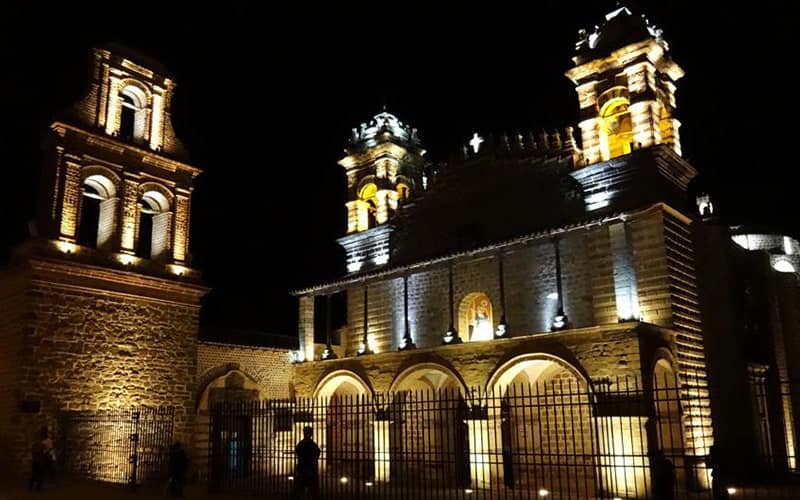
Ayacucho’s Folk Arts and Handicrafts
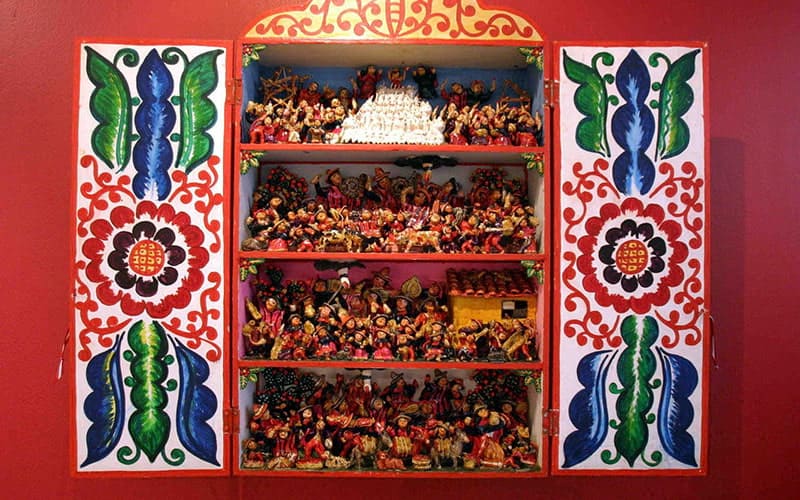
Ayacucho is also known as “Peru’s Capital of Folk Arts and Handicrafts”, and much of the artisan work produced by Ayacuchanos is exported to Europe, North America and Asia.
Retablos are the most famous artisan offering- they were originally made from portable altars boxes, but have developed into outrageous collections of tiny hand-carved wooden or clay figurines and other beautiful objects, crammed into several layers inside the box. These are beautiful expressions of the Ayacucho people and culture, they all have plenty of colors and are sometimes very funny. If you’re looking to see the master craftsmen at work, it’s highly recommended to visit the Shosaku Nagase Handicraft Market, located just 5 blocks from the central plaza. The best workshops are in the barrios of Santa Ana, Puca Cruz, Belén and La Libertad.
Holy Week in Ayacucho
Originally celebrated in Spain, this is the most famous religious feast in Peru, and it represents sacrifice and death of Jesus in the cavalry. All the citizens participate in this celebration, and people from surrounding cities arrive in caravans to Ayacucho, ready to take part in the religious devotion. This is one of the many religious festivals in Peru.
The celebration begins on Sunday, or “Domingo de Ramos” (Palms) and ends the next Sunday with the “Domingo de Pascua” (Easter). One of the most important events during Holy Week is the processions and religious manifestations that are accompanied by folkloric dances. Alongside these celebrations, artisan and cattle fairs take place throughout the whole week.
Very early in the morning on the first Sunday of the festival donkeys and llamas are adorned with herbs from the local area before entering the city. This is representative of the triumphant entrance of Jesus to Jerusalem. On the Thursday of the holy week, it is traditional for citizens to visit all of the 33 churches in the city. Saturday is the day in which “morochucos” (cowboys of the Andes), ride their horses up the Acuchimay Mountain alongside the people from Ayacucho.
On the last Sunday of the festival, all of the churches in Ayacucho ring their bells, waking up the citizens. It is then traditional to go to the Cathedral, carrying a very big depiction of Jesus brought back to life. This brings a close to this special Holy Week.
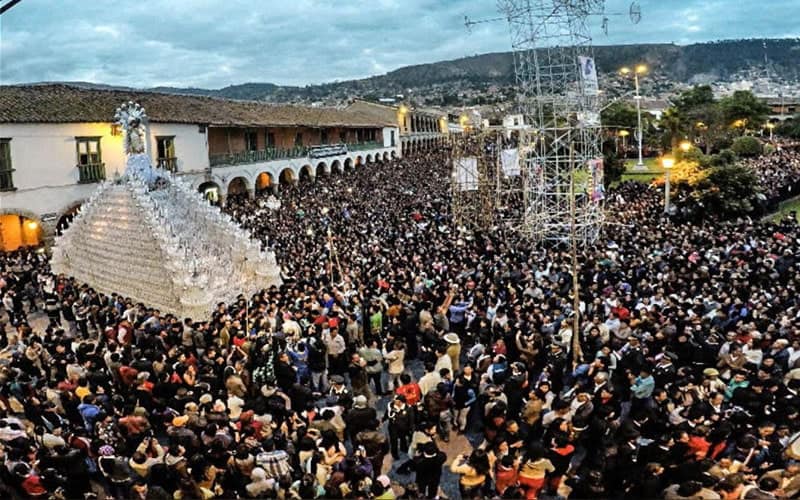
How to Get Ayacucho
By Air
Regular flights leave from Lima to Ayacucho and take 45 minutes.
By Land
Lima – Ayacucho (via Livertadores) : 7 hours by car/bus
Huancayo – Ayacucho (via Colcabamba): 6 hours by car/bus
Huancavelica – Ayacucho (via Rumichaca): 5 hours by car/ bus
Don’t Miss Out!
There is plenty of tradition, folklore, and handicrafts to soak up and enjoy here. Ayacucho is a must-see destination during your visit to Peru. Enjoy the city, people, the food and handicrafts that make Ayacucho a spot that you can not miss on your Peruvian adventure! What are you waiting for? Plan your trip!


